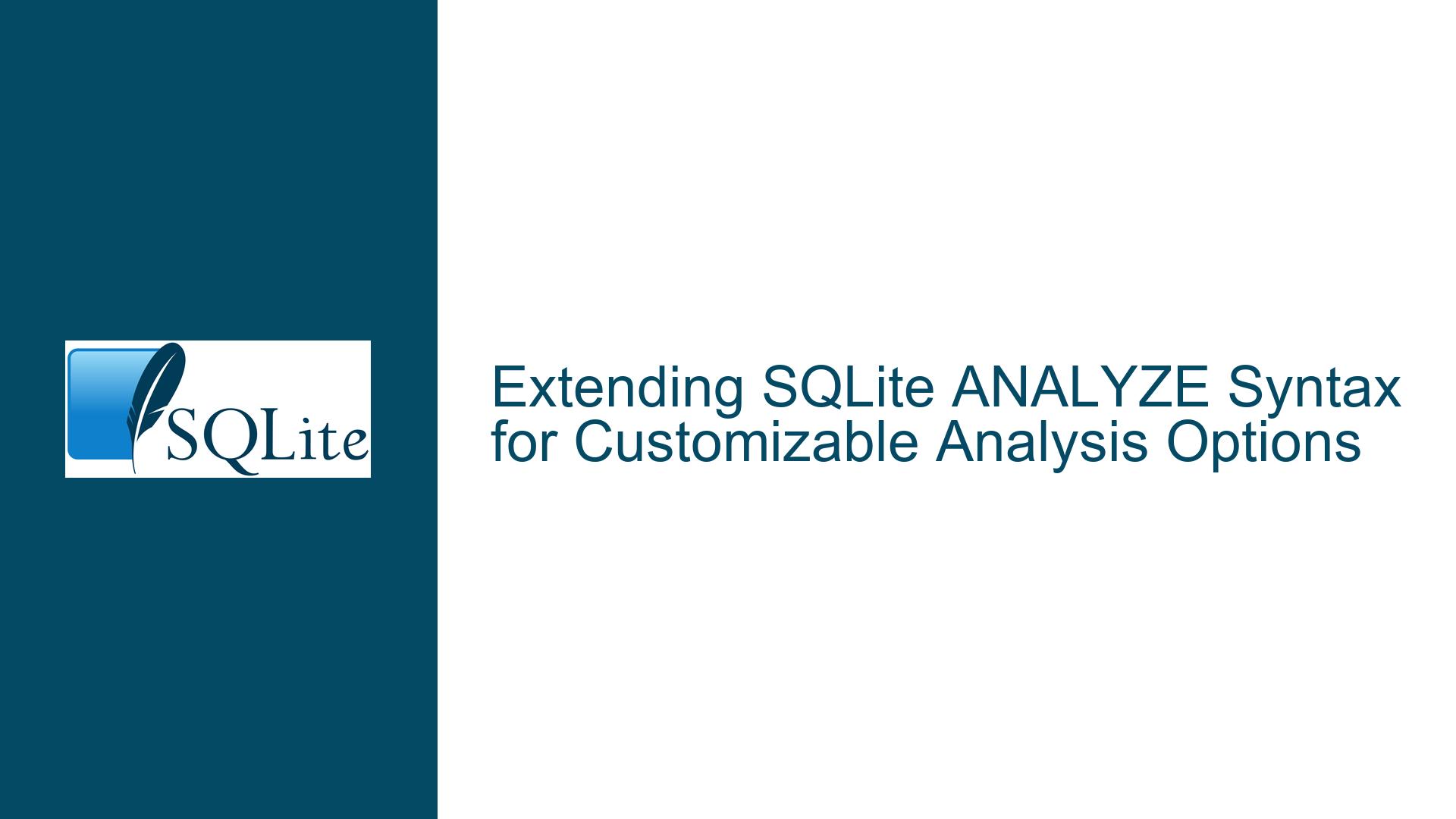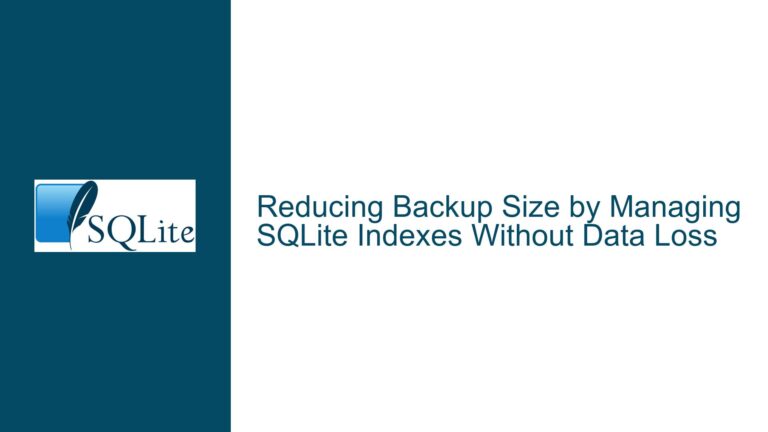Extending SQLite ANALYZE Syntax for Customizable Analysis Options
SQLite ANALYZE Command Limitations and Proposed Extensions
The SQLite ANALYZE command is a powerful tool for collecting statistical information about tables and indexes, which the query planner uses to optimize query execution. However, the current implementation of ANALYZE in SQLite is relatively simplistic compared to other database systems like PostgreSQL and MySQL. Specifically, SQLite’s ANALYZE lacks the ability to specify options that modify its behavior, such as controlling the level of detail in the analysis or adjusting the sample size for statistical calculations. This limitation can lead to inefficiencies, especially in scenarios where a quick, superficial analysis is sufficient, or where a more detailed analysis is required for optimal query planning.
The current syntax for ANALYZE in SQLite is:
ANALYZE [table-or-index-or-collation-name];
This syntax does not allow for any additional parameters or options, which restricts the flexibility of the command. For example, in PostgreSQL, you can use the VERBOSE option to control the level of detail in the analysis, while MySQL allows options like NO_WRITE_TO_BINLOG or LOCAL to modify the behavior of ANALYZE. SQLite, on the other hand, does not support any such modifiers, which can be a significant limitation for applications that require fine-grained control over the analysis process.
To address this limitation, there is a proposal to extend the ANALYZE syntax in SQLite to support a variety of options that can modify its behavior. These options could include parameters like samples=25, FAST, or STAT1_ONLY, which would allow applications to trade off precision and runtime according to their specific needs. For example, a quick but superficial analysis could be performed using the FAST option, while a more detailed analysis could be performed using the STAT1_ONLY option. This would provide greater flexibility and control over the analysis process, allowing applications to optimize their query planning based on their specific requirements.
However, extending the ANALYZE syntax in this way introduces several challenges, particularly in terms of grammar and syntax ambiguity. For example, consider the following proposed syntax:
ANALYZE samples=25, FAST main.sometable;
In this case, it is unclear whether the command is intended to analyze all tables using the samples=25 and FAST options, or whether it is intended to analyze a specific table named FAST with the samples=25 option. This ambiguity arises because the ANALYZE command in SQLite allows the table name to be optional, which complicates the parsing of additional options.
To resolve this ambiguity, several alternative syntax proposals have been suggested. One approach is to use a keyword like USING to separate the options from the table name, as in:
ANALYZE main.sometable USING samples=25, fast;
Another approach is to enclose the options in parentheses, as in:
ANALYZE (samples=25, fast) main.sometable;
Both of these approaches aim to make the syntax clearer and less ambiguous, but each has its own advantages and disadvantages. The USING keyword approach is more verbose but may be easier to read and understand, while the parentheses approach is more concise but may be less intuitive for some users.
Ambiguity in Proposed ANALYZE Syntax and Grammar Challenges
The primary challenge in extending the ANALYZE syntax in SQLite is ensuring that the new syntax is both clear and unambiguous, particularly in cases where the table name is optional. This is a non-trivial problem because the ANALYZE command in SQLite can be used without specifying a table name, which means that any additional options must be clearly distinguishable from the table name itself. This is particularly important in cases where the options include keywords that could be mistaken for table names, such as FAST or STAT1_ONLY.
One proposed solution to this problem is to use a keyword like USING to separate the options from the table name. For example:
ANALYZE main.sometable USING samples=25, fast;
In this syntax, the USING keyword clearly indicates that the following terms are options rather than table names. This approach has the advantage of being relatively easy to read and understand, but it does introduce additional verbosity to the syntax. Additionally, the USING keyword is already used in other parts of SQL, such as in JOIN clauses, which could potentially lead to confusion if it is also used in the ANALYZE command.
Another proposed solution is to enclose the options in parentheses, as in:
ANALYZE (samples=25, fast) main.sometable;
This approach has the advantage of being more concise and visually distinct, which could make it easier to parse and understand. However, it also introduces the potential for ambiguity in cases where the options are not clearly separated from the table name. For example, consider the following command:
ANALYZE (samples=25, fast);
In this case, it is unclear whether the command is intended to analyze all tables using the samples=25 and FAST options, or whether it is intended to analyze a specific table named FAST with the samples=25 option. This ambiguity arises because the parentheses could be interpreted as part of the table name, particularly if the table name itself contains special characters or spaces.
A third proposed solution is to use a keyword like WITH to separate the options from the table name, as in:
ANALYZE main.sometable WITH samples=25, fast;
This approach is similar to the USING keyword approach but uses a different keyword that may be more familiar to users of other SQL databases. However, like the USING keyword approach, it introduces additional verbosity to the syntax and could potentially lead to confusion if the WITH keyword is used in other contexts.
Implementing PRAGMA-Like Options and Syntax Clarity
One potential solution to the ambiguity problem is to adopt a syntax similar to the PRAGMA command in SQLite, which allows for the specification of options using a key-value format. For example:
PRAGMA analyze_settings = 'samples=25, fast';
In this syntax, the options are specified as a string, which eliminates the ambiguity between options and table names. This approach has the advantage of being consistent with the existing PRAGMA syntax in SQLite, which is already familiar to many users. Additionally, it allows for the specification of multiple options in a single command, which could be useful for complex analysis scenarios.
However, this approach also has some disadvantages. First, it requires the use of a separate command (PRAGMA analyze_settings) to configure the options for the ANALYZE command, which could be seen as less intuitive than specifying the options directly in the ANALYZE command itself. Second, it introduces additional complexity in terms of managing the state of the options, particularly in cases where the options need to be changed frequently or where different options are needed for different tables.
Another potential solution is to combine the PRAGMA-like syntax with the ANALYZE command itself, as in:
ANALYZE main.sometable WITH (samples=25, fast);
In this syntax, the options are specified in parentheses after the WITH keyword, which makes it clear that they are separate from the table name. This approach has the advantage of being both concise and clear, while also allowing for the specification of multiple options in a single command. Additionally, it is consistent with the syntax used in other SQL databases, such as PostgreSQL, which could make it easier for users to understand and adopt.
Ultimately, the choice of syntax will depend on a variety of factors, including the need for clarity, consistency, and ease of use. Regardless of the specific syntax chosen, it is important to ensure that the new ANALYZE syntax is both flexible and unambiguous, so that it can be used effectively in a wide range of scenarios. By carefully considering the trade-offs between different syntax proposals, it should be possible to develop a solution that meets the needs of both developers and users while maintaining the simplicity and elegance that SQLite is known for.






